Cards In This Set
| Front | Back |
|
Talk about Pine - part of coniferophytus. What type of environment is it adapted for? how?
|
The sporophyte generation of pine is a woody tree that is particularly well adapted to grow in a xerophytic (dry) environment. Canada's water supply is frozen for many months of each year, a climatic factor that simulates desert conditions. The needle-like leaves of pine have a very heavy cuticle, a thick walled epidermis, and deeply sunken stomata with overhanging cells to prevent desiccation and to slow down transpiration. Also, pine needles (leaves) do not accumulate snow. Imagine how a maple tree would weather a Montreal winter if it kept its leaves all year. Pines and most gymnosperms are indeciduous or "evergreen". In reality, the leaves drop after two years but not all at once. Their continuous presence permits photosynthesis to take place year-round whenever the temperature rises above 2oC. This gives evergreens a much longer growing season, a decided advantage over deciduous trees in northern climates.
|
|
What are the obvious structures on mature conifers?
|
Cones or strobili (singular:strobilus). Each of these
reproductive structures consist of a stem (axis) with many scales each bearing a pair of sporangia in which haploid spores |
|
Describe the structure of a male cone
|
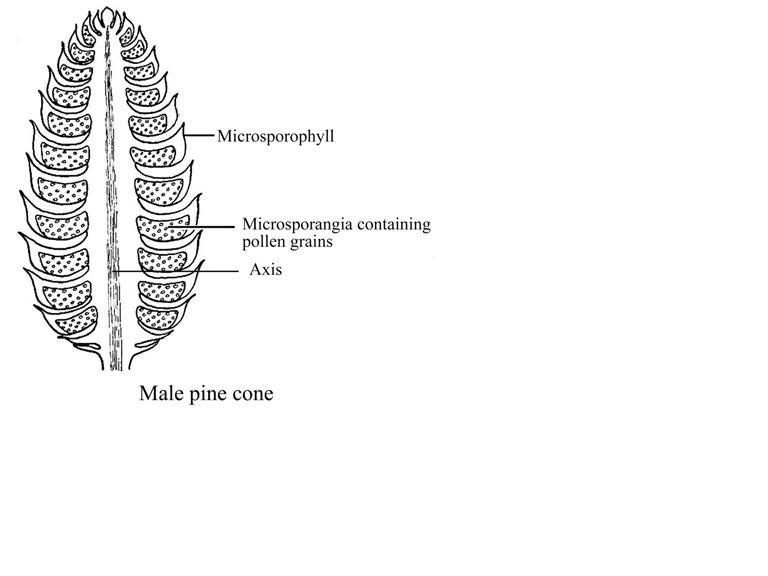 A male cone is a stem (or axis) bearing scales. The scales are modified leaves called microsporophylls. There are two microsporangia (or pollen sacs) on each microsporophyll. Within the former, microspore cells are formed by meiosis. These haploid microspores begin to develop into haploid microgametophytes (male gametophytes) while within the microsporangium. At the time the immature microgametophytes are shed, they are called pollen. |
|
Mature pollen grain - see the various types of cells
|
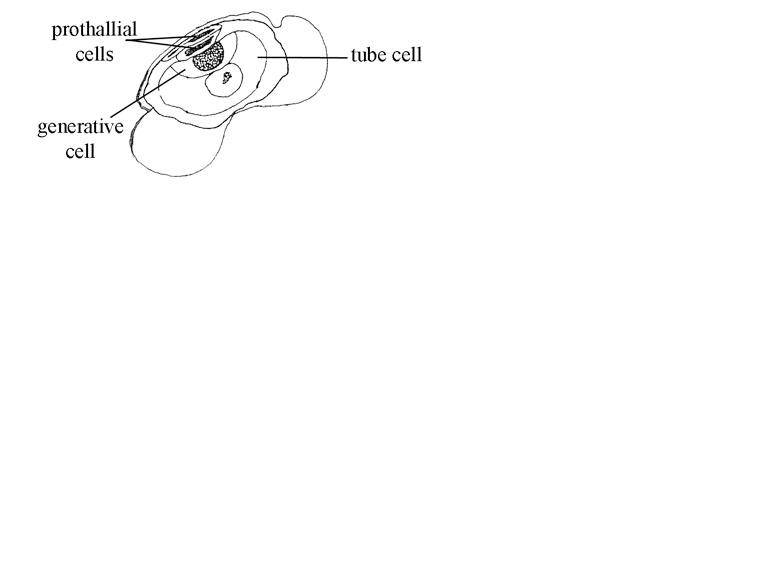 If the pollen has matured to thepoint of shedding, then the pollen grains or microgametophytes are four cells in size. Two are vegetativeprothallial cells. They are vestiges of cells crushed at one side of the pollen grain and will degeneratelater on. The other two are the tube cell and the generative cell. Once a pollen grain reaches a femalecone, it will complete its development and a sperm cell produced by the generative cell will fertilize theegg. A pollen tube produced by the tube cell will conduct the sperm to the egg. |
|
Describe the anatomy of a female cone with reference to the stem/axis, scales, megasporangium, integument, micropyle, megaspores, megagametophyte, archegonia
|
The female cone consists of a stem (or axis) bearing scales, each of which is a modified branch, not leaf.These ovuliferous scales each have a pair of ovules on their upper surfaces. Each ovule contains amegasporangium (or nucellus) surrounded by an integument. An opening in the integument, themicropyle, is where the pollen grain will enter for fertilization. Inside the megasporangium, fourmegaspores will form by meiosis. Three megaspores will disintegrate but the fourth will develop into thehaploid female gametophyte or megagametophyte. At maturity, the megagametophyte will consist ofabout 2000 cells plus a few archegonia each with an egg cell. Although several eggs in an ovule may befertilized, usually only one develops into an embryo. When more than one embryo forms (about 3-4% ofthe time), then one seed will be able to produce two or more seedlings upon germination.
|
|
When are female cones fertilized?
|
Female cones develop in the spring and are pollinated and then close when only 0.5 cm long.Fertilization takes place after the pollen matures, generally 12 to 14 months later. Pine cones then, are notmature until the fall of the second year following their formation. At maturity, they are large and woodyand bear seeds on the upper surfaces of their scales.
|
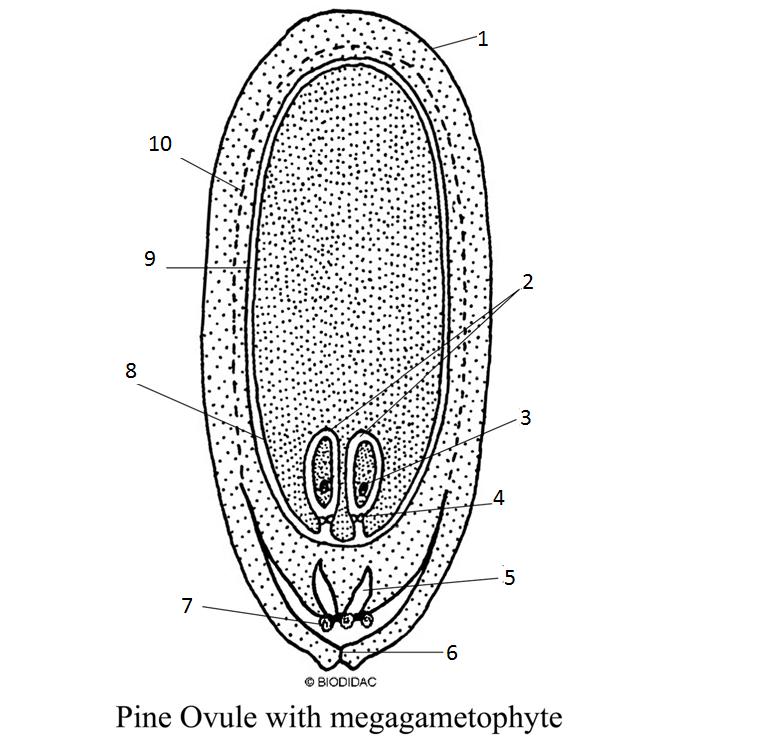 Label the parts of the female cone |
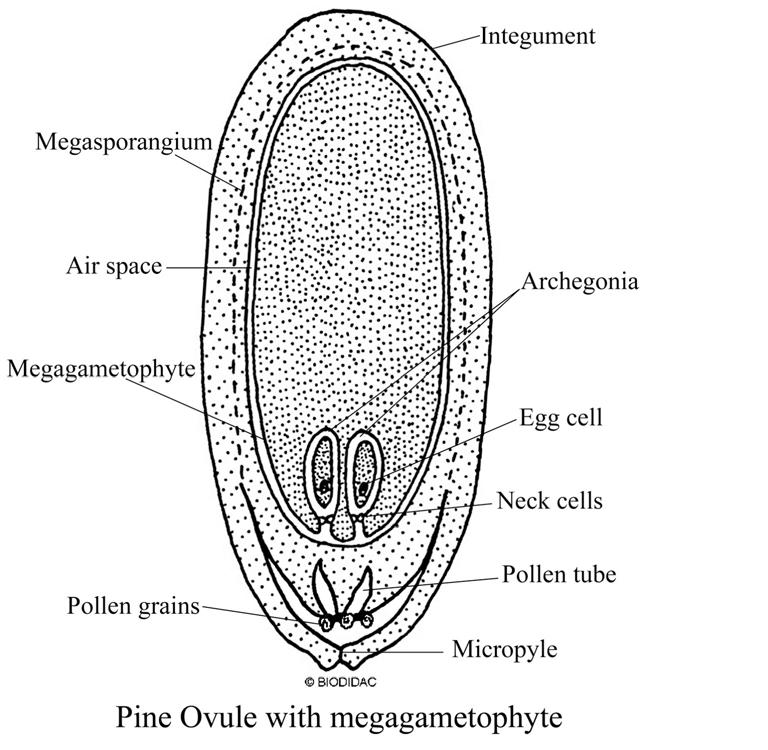 Label them! |
|
Describe the gametophyte seed
|
Once sperm has fertilized the egg and the resulting embryo has developed, the ovule has become a seed.The seed coat derives from the integument of the ovule with an extended flap forming a wing to aid indispersal. Inside the seed is the sporophyte embryo surrounded by tissue derived from themegagametophyte. This food storage tissue supplies the early needs of the germinating plant. Note thatsince there is no extra tissue from outside of the ovule around the seed, the seed is considered naked.The only protection for the seeds are the scales of the cone that remain tightly pressed against each otheruntil the seed is to be dispersed.
|
|
What are angiosperms? What are the two divisions?
|
Angiospermae are seed plants with ovules enclosed within sporophyte tissue, that is, within an ovary.The ovary persists to become the fruit when the ovules within have become seeds. In the Angiospermae,the reproductive structures are contained within a specialized structure called the flower. This is incontrast with the Coniferophyta in which the ovules remain exposed. There are two main classes withinthe phylum Angiospermae, the Monocotyledones (monocots) and the Eudicotyledones (eudicots).
|
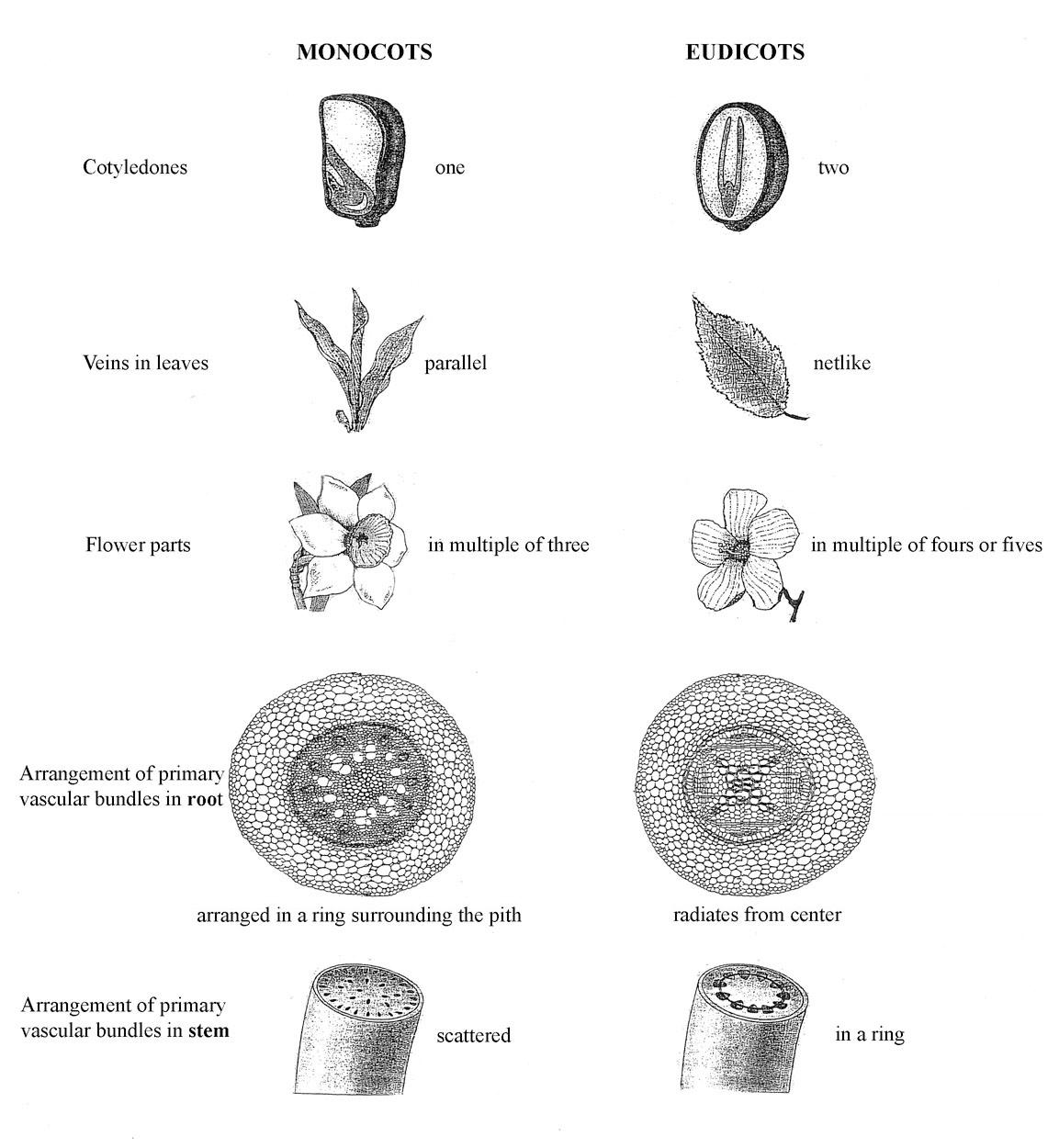 Compare monocots and dicots |
Discuss the Cotyledons Veins in LeavesFlower partsArrangement of root vascular bundlesArrangement of stem VB
|
|
What makes up the shoot system?
|
Stems and leaves - the flower is the reproductive structure
|
|
Discuss the organ tissues of angiosperms.
|
The organs of both the reproductive and vegetative regions may consist of the following tissues:epidermis, cortex, endodermis, pericycle, xylem, phloem and pith. In leaves, mesophyll occurs insteadof cortex and pith. In stems and roots, cork and cork parenchyma may be found in addition to the othertissues. Two kinds of embryonic tissues are distinguished: the apical meristems produce the primarymeristems and the cambia (singular: cambium) produce the lateral meristems, tissues you will viewlater.
|
|
What is the hierarchy of organization?
|
Cells Tissue Organ Organ system Organism
|
|
Look at brassica. Try to answer these questions: At what level is the main root thickest in diameter? Can you identify a level on the main axis of the plant where the root "joins" the stem or is there a“transition” zone that is not recognizable as root or shoot.
|
Yes
|
|
What is the function of the Epidermis, cortex, endodermis, pericycle, phloem, xylem, cambium
|
1. Epidermis: a single surface layer of cells that protects the root and absorbs water and minerals. Root hairs are extensions of epidermal cells.2. Cortex: thin-walled storage cells, many with starch grains inside (stained violet). The irregularintercellular spaces between the cells permit aeration. The outermost layers of cortex may be tightly packed and are referred to as the exodermis if the cells contain suberin (as is the case withRanunculus), and the hypodermis if the cells are relatively unmodified. These layers protect theroot, and in the case of exodermis, will help prevent water loss from the root.3. Endodermis: the innermost layer of the cortex. A single layer of endodermal cells. The thickwalled cells contain suberin, which makes them impervious to water, while the thin walled cells,called passage cells, allow water to pass. They are opposite the points of the xylem. Can you see any significance in the positioning of the passage cells?4. Pericycle: one or more layers of thin-walled parenchyma cells that function in food storage. Lateral roots originate from this tissue layer. This tissue type occurs in roots only.5. Phloem: groups of thin-walled cells between the “arms” of the xylem.6. Xylem: mainly thick-walled, angular vessel elements (stained red) arranged in the form of a cross or a three armed star radiating from the center of the stele (aggregates of vascular tissue which take the form of a central cylinder in roots). Eudicots characteristically have from 2 to 5 xylem “arms”.7. Cambium: thin walled irregular cells found between the groups of phloem and the central mass of xylem. These cells are meristematic and will play a role in secondary growth, if it occurs.
|



